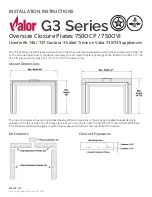
2.3.4 Dangers of Creosote ………………………………….……………..12
2.3.3 Building a Fire ……………………………………………….....….11-12
2.3.5 Maintaining the Fire .......................................................................12
2.3.6 Combustion Air…............................................................................12
2.3.7 The use of Composite Ecological logs …………………...............12
2.3.8 Smoking - Causes and Troubleshooting.................................12-13
2.4 MAINTAINING THE TATIANA FIREPLACE AND CHIMNEY……..…13
2.4.1 Fireplace and Chimney Maintenance...........................................13
2.4.2 Annual and Seasonal Inspections................................................13
2.4.3 Care and Cleaning of the exterior of the fireplace ………….…...13
2.4.4 Disposal of Ashes ……………………………………………….….....14
2.4.5 Dealing with a Chimney Fire ……………………..……………....….14
2.4.6 Replacement Parts list and Combustion Air Intake…………..…15
2.5 WARRANTY ………………………………………………………….....16-17
ADDENDUM: Addition of Vented Gas Fire Log to Tatiana 997CFO..18-19-20-21-22-23
1. SAFETY RULES FOR OPERATING FIREPLACE
Warning: This fireplace is designed to be operated with the firescreen always in place. If the
firescreen is not in place or partly open, flames and firebrands may be drawn out of the fireplace
opening creating risks of both fire and smoke which could result in loss of life or serious injuries
and/or important material damages.
1. Teach children fireplace safety rules and do not let children under eight get near the fireplace.
2. Do not use the fireplace under the following conditions:
2.1 Stop using the fireplace whenever the firescreen is even slightly damaged or broken.
2.2 Whenever any part of the smoke pipe or chimney is loose or not in a proper working order.
3. Never use flammable liquids to light or revive a fire and keep such products away from any heat
source. Before lighting a fire, make sure there are no flammable liquids, gases or fumes in the room.
4. Before starting each fire, open the flue damper fully (using the damper cane ) by turning the key
located above the fireplace on the smoke pipe.
5. During extremely cold weather, preheat the chimney flue to prevent smoke flow reversal. Hold a
lighted rolled up newspaper inside the fireplace towards the smoke pipe for a few minutes.
6. Only use the grate made by JC Bordelet S.A.S. to build a fire. Only burn the quantity of firewood it
can hold (Max. 11 kg/24 lbs). Never overfire the fireplace, if any part of the fireplace or smoke pipe is
glowing red, then you are overfiring. Stop feeding the fire immediately. The high temperature
caused by overfiring can permanently damage the fireplace, smoke pipe, chimney and nearby
combustible walls and ceilings.
7. To prevent deformation of the grate, always leave a min. 2.54cm (1”) of ash in the bottom.
8. When using the fireplace for the first couples of times, make small fires ( Max. 5.5kg/12lbs) of
firewood to give the painted finish of the fireplace and smoke pipe time to cure properly.
9. During the first fire, you may detect certain odors and the coating and oil protecting certain parts
may smoke a little. Open a window, to quickly dispel these fumes.
11. Expansion and contraction noises during the heating and cooldown cycle are normal.
12. When the fireplace is in full operation and hot, do not tamper with the damper key.
13. Once the fire is out and the fireplace, smoke pipe and the embers have cooled, close the smoke
pipe damper (using the damper cane) until you prepare to light the next fire.
14.
When cleaning out the fireplace, always wait at least 24 hours before removing the ashes with
an all-metal vacuum cleaner such as a Charlescraft Bad Ash 2. Then quickly empty the vacuum
cleaner into a metal ash container with a tight fitting lid. The closed ash container should then be
placed on a non-combustible floor or on the ground outside, pending final disposal. If the ashes are
disposed of by burial in soil or otherwise locally dispersed, they should be retained in the closed
container until all embers have cooled.
Page 3




































